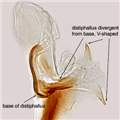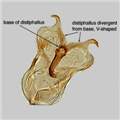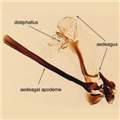
mines on broccoli (R. Murtiningsih)

aedeagus (L. Semeraro)

aedeagus (dorsal) (L. Semeraro)

male genitalia (L. Semeraro)
Nomenclature
Chromatomyia horticola (Goureau 1851)
Agromyza atricornis Meigen 1830 nomen dubium Phytomyza geniculata Macquart 1835 nomen dubiumPhytomyza atricornis (partim) Meigen 1838 sensu Hendel 1920Phytomyza horticola Goureau 1851 Phytomyza cucumidis Macquart 1855 Phytomyza tropaeoli Dufour 1857 Phytomyza fediae Kaltenbach 1860 Phytomyza linariae Kaltenbach 1862Phytomyza pisi Kaltenbach 1864 Phytomyza subaffinis Malloch 1914Napomyza lactucae Vimmer 1926Phytomyza bidensivora S�guy 1951 Phytomyza nainiensis Garg 1971
Common name: pea leafminer
Hosts
Highly polyphagous. Recorded from 268 genera from 36 families in all subclasses but most commonly on Brassicaceae, Fabaceae and Asteraceae (Spencer 1989, 1990).
Distribution
Africa: Cameroon, Cape Verde, Central African Republic, Congo Democratic Republic, Egypt, Eritrea, Ethiopia, Gabon, Gambia, Kenya, Libya, Madagascar, Morocco, Rwanda, Senegal, South Africa, Uganda, ZimbabweAsia: China, India, Indonesia, Iraq, Israel, Japan, Democratic People's Republic of Korea, Republic of Korea, Kuwait, Malaysia, Mongolia, Nepal, Philippines, Sri Lanka, Taiwan, Thailand, VietnamEurope: Austria, Belgium, Bosnia and Herzegovina, Bulgaria, Croatia, Czech Republic, Denmark, Finland, France, Germany, Hungary, Ireland, Italy, Lithuania, Macedonia, Malta, Montenegro, Netherlands, Poland, Portugal, Russian Federation, Serbia, Spain, Sweden, Switzerland, Ukraine, United Kingdom
Based on data from Crop Protection Compendium (2007).
Key characters
Third antennal segment and palps black. Mesonotum matt grey. Coxae black, femora black with apex yellow, tibiae and tarsi black. Costa ending at vein R4+5, second (outer) cross-vein (dm-cu) absent. This species cannot be distinguished from C. syngenesiae on external morphology but the male gentitalia are different (Griffiths 1967, 1972; Spencer 1973). Distiphallus strongly developed and divergent from base, V shaped.
Notes
The larva forms a narrow, linear mine on the upper or lower leaf surface. Pupation is in the mine (Spencer 1973). Chromatomyia horticola has a much wider host range than C. syngenesiae and would be an important horticultural pest in Australia. Because of the great difficulty in distinguishing between the two species on external characters (Dempewolf 2004), and because of the widespread distribution of C. syngenesiae in Australia, detection of C. horticola will be difficult and there is a need to have access to a robust molecular diagnostic test to enable all life stages to be identified. The extensive parasitoid fauna attacking C. syngenesiae in Australia (Bjorksten et al. 2005) would be available to attack C. horticola once it became established.
A recent phylogenetic study of the Agromyzidae employing molecular markers (Scheffer et al. 2007) showed that Chromatomyia was in fact a polyphylectic genus, suggesting that this genus should now be included in Phytomyza.
References
Bjorksten TA, Robinson M & La Salle J (2005). Species composition and population dynamics of leafmining flies and their parasitoids in Victoria. Australian Journal of Entomology 44: 186-91.
Crop Protection Compendium (2007). 2007 Edition � CAB International, Wallingford, UK.
Dufour L (1857). M�langes entomologiques. Annales de la Soci�t� Entomologique de France (3) 5: 39-70.
Garg PK (1971). Studies on Agromyzidae (Diptera) from the Gangetic Basin. Part V. Descriptions of three new species of Phytomyza Fallkn. Oriental Insects Supplement 1: 247-256.
Goureau CC (1851). M�moire pour servir � l'histoire des dipt�res dont les larves minent les feuilles des plantes, et � celle de leurs parasites. Annales de la Soci�t� Entomologique de France (2) 9: 131-76.
Griffiths GCD (1967). Revision of the Phytomyza syngenesiae group (Diptera, Agromyzidae), including species hitherto known as "Phytomyza atricornis Meigen". Stuttgarter Beitr�ge zur Naturkunde 177: 1-28.
Griffiths GCD (1972). Comment on Steyskal's note on Phytomyza horticola Goureau and P. syngenesiae (Hardy) (Diptera, Agromyzidae). Entomological News 83: 39-40.
Hendel F (1920). Die pal�arktischen Agromyziden: Prodromus einer Monographie. Archiv f�r Naturgeschichte (A) 84: 109-174.
Kaltenbach JH (1860). Die deutschen Phytophagen aus der Klasse der Insekten. Fortsetzung. Alphabetisches Verzeichniss der deutschen Pflanzengattungen (Buchstabe D-F). Verhandlungen des naturhistorischen Vereins der preussischen Rheinlande und Westfalens 17: 203-260.
Kaltenbach JH (1862). Die Phytophagen aus der Klasse der Insekten. Fortsetzung. Alphabetisches Verzeichniss der deutschen Pflanzengattungen (Buchstabe G-L). Verhandlungen des naturhistorischen Vereins der preussischen Rheinlande und Westfalens 19: 1-106. Kaltenbach JH (1864). Die Phytophagen aus der Klasse der Insekten. Fortsetzung. Alphabetisches Verzeichniss der deutschen Pflanzengattungen (Buchstabe M-P). Verhandlungen des naturhistorischen Vereins der preussischen Rheinlande und Westfalens 21: 228-404.
Macquart JPM (1835). Histoire naturelle des insectes. Dipt�res. 2. Roret, Paris 710 pp.
Macquart J (1855). Les plantes herbace�s d'Europe et leurs insects. 2. Partie. M�moires de la Soci�t� Imp�riale des Sciences, de l'Agriculture et des Artes de Lille (1854): 157-330.
Malloch JR (1914). Formosan Agromyzidae. Annales Historico-Naturales Musei Nationalis Hungarici 12: 306-336.
Meigen JW (1830). Systematische Beschreibung der bekannten europ�ischen zweifl�geligen Insekten. Sechster Theil mit zw�lf Kupfertafeln 6: 166-196.
Meigen JW (1838). Systematische Beschreibung der bekannten europ�ischen zweifl�geligen Insekten. Siebenter Theil oder Supplementband. 7: 396-407.
S�guy E (1951). Dipteres mineurs de Madagascar. M�moires de l�Institut Scientifique de Madagascar, Tananarive (A) 5: 309-321.
Scheffer SJ, Winkler IS & Wiegmann BM (2007). Phylogenetic relationships within the leaf-mining flies (Diptera: Agromyzidae) inferred from sequence data from multiple genes. Molecular Phylogenetics and Evolution 42: 756-775.
Spencer KA (1973). Agromyzidae (Diptera) of economic importance. Series Entomologica 9. Dr W Junk, The Hague. 418 pp.
Spencer KA (1989). Leaf miners. In Plant Protection and Quarantine, Vol. 2, Selected Pests and Pathogens of Quarantine Significance (ed. Kahn RP). CRC Press, Boca Raton, pp. 77-98.
Spencer KA (1990). Host specialization in the world Agromyzidae (Diptera). Series Entomologica 45. Kluwer Academic Publishers, Dordrecht. 444 pp.
Vimmer A (1926). O nov�m druhu rodu Napomyza Hal. (Dipt. - Agromyzidae). Uber eine neue Art der Gattung Napomyza Hal. (Dipt. - Agromyzidae). Sborn�k entomologick�ho oddelen� N�rodn�ho Musea v Praze. 4: 117.
WWW Resources
Chromatomyia horticola in Dempewolf M (2004). Arthropods of Economic Importance - Agromyzidae of the World
Chromatomyia horticola, leaf symptoms in Edmunds R et al. (2008). British leafminers
Chromatomyia horticola in Pitkin B, Ellis W, Plant C & Edmunds (2008). The leaf and stem mines of British flies and other insects
Chromatomyia horticola in Ellis WN (2018). Plant Parasites of Europe - leafminers, galls and fungi
Chromatomyia horticola in Martinez M (2007). Fauna Europaea: Agromyzidae. In Pape T (ed.) (2007) Fauna Europaea: Diptera: Brachycera. Version 1.3 [128298]




















